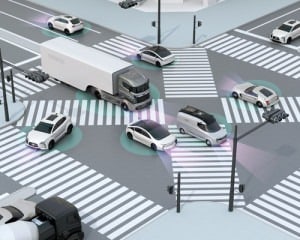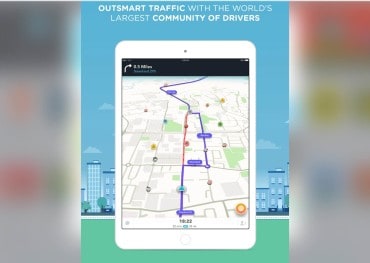
Autonomous vehicles will soon be on more streets, meaning more interactions with humans. What can we glean from other sectors to make this rollout safer?
The IoT is moving at the speed of light, with new technological breakthroughs happening every day. The initial IoT innovations ramped up slowly over the past few decades, implementing new communication technologies mainly for industrial applications. Now that consumer IoT has kicked into high gear, with real-time connectivity of all “things” becoming business-critical, companies across several industries are determining how they too can incorporate IoT into their processes and products.
It’s tempting to lump autonomous vehicles into that broad IoT category because many of the same principles apply—artificial intelligence (AI) taking over where humans were once required. But the automotive industry faces something that most IoT products do not: a multiyear development cycle, and complex validation and reliability testing requirements. While there are significant differences in the two markets, automotive OEMs and suppliers are quickly adapting to the successful business models of IoT, creating flexible vehicle system architectures which allow for quicker adaptations of fast-to-market, next -generation, leading-edge IoT technologies.
See also: Cybersecurity vehicles threat not just limited to autonomous cars
Automotive companies will not only need to meet the requirements of discriminating consumers from a real-time customer experience and timeline perspective, but also from an ever-growing reliability and safety perspective required to produce zero-defect autonomous vehicles.
The Market for Autonomous Vehicles Shapes Up
Nearly every vehicle today has basic automation capabilities, including basic or adaptive cruise control. Many vehicles have the additional capabilities of lane departure warnings, blind spot monitoring, forward warning collision avoidance, automated braking systems, backup warning systems, parking assist and automated parking, and electronic stability systems.
By 2040, however, Loup Ventures expects that more than 90% of all vehicles sold will be “Highly” and “Fully” autonomous systems, based on these Level 0-Level 5 classifications from the National Highway Traffic Safety Administration (NHTSA):
- Level 0: No Automation—A human driver controls the critical driving functions.
- Level 1: Driver Assistance—The vehicle can perform some basic driving function, such as maintaining a steady speed through cruise control, but the driver maintains control of the vehicle.
- Level 2: Partial Automation—The car can perform one or more driving tasks at the same time, including steering and accelerating, but requires the driver remain alert and in control of the vehicle.
- Level 3: Conditional Automation—The car drives itself under certain conditions but requires the human to intervene upon request with sufficient time to respond. The driver, however, isn’t expected to constantly remain alert.
- Level 4: High Automation—The car performs all critical driving tasks, monitors roadway conditions the entire trip, and doesn’t require the human to intervene. However, autonomous driving is limited to certain locations and environments.
- Level 5: Full Automation—The car drives itself from departure to destination without any human intervention.
The fully autonomous vehicle-to-vehicle (V2V), vehicle-to-infrastructure (V2I), and vehicle-to-network (V2N) technologies and testing standards are not yet finalized. Prior to achieving a complete market acceptance of Level 5 full automation, auto manufacturers will continue to hone and implement new technologies into the existing semi-autonomous model. The evolution of semi to fully autonomous vehicles will be influenced by future safety, legal, and other regulatory requirements.
The Need for Speed (to Market)
While vehicle development cycle timelines have been significantly reduced over the past years, the typical design cycle of vehicles is still three to five years. However, IoT and communication technology moves so quickly, by the time a vehicle hits production, it may be missing a generation or two of what’s available in the IoT market. With leading-edge technology advancements, such as 5G wireless connectivity, and with ever-increasing and evolving system complexities, automotive OEMs are creatively seeking ways to offer the latest IoT technologies to their end consumers at nearly the same pace.
Today’s connected vehicles require reliable communication connections for all the safety features mentioned above, and also for real-time vehicle diagnostics and software updates. As the industry moves towards autonomous vehicles, the connectivity requirement grows exponentially. Regardless of their location, drivers need consistent, real-time access to high-speed, reliable, low-latency connectivity for safety-critical applications such as V2V, V2I, and V2N systems, as well as for data collection and analytics for AI applications.
The automotive ecosystem is incredibly complicated, involving several industrial, regulatory, global standards and testing, and system developer companies and organizations. Companies that offer development tools, sensors, connectivity, mapping, algorithms, security and safety, and autonomous features all have a piece of this highly complex ecosystem that needs seamless integration for the market to succeed.
See also: Is the coming autonomous vehicle age the end of B2C?
Take vehicle antennas—complex in their own right—and just one part of the connected and autonomous puzzle. With the myriad antennas required to deliver even basic capabilities, where and how should they be placed in a vehicle while taking into consideration cost, size, installation flexibility, and performance is complex—and takes time.
The types of antennas required for today’s cars range from the basic to the advanced and includes AM/FM/Satellite radio antennas; cellular antennas that are required for network connectivity; GNSS antennas for navigation, emergency call systems, and other location-based technologies; Bluetooth antennas to provide connectivity for smartphones and other mobile devices; Wi-Fi antennas for hotspot connectivity; radar antennas for object detection; and V2V, V2I, and V2N antenna system requirements via DSRC and C-V2X applications.
The sheer number of antennas needed for the future connected car present challenges to the automotive styling designers. Auto manufacturers have been working on both distributed antenna systems, incorporating into the vehicle body, side pillars, bumpers, rooftop, as well as interior glass locations, along with fully integrated low-profile, small-form-factor packages under plastic composite structures, like the rear spoiler and plastic trunk lids. The challenge, however, is coordinating the development of a vehicle’s antenna system in a way that guarantees 100%, uninterrupted, reception of communication signals, as well as high-precision centimeter accuracy location capability.
The challenge for the automotive industry is to ensure all the infrastructure, standards, and legal requirements are managed in such a way so that automobile manufacturers have the flexibility to implement the latest technologies when mass production occurs. Likewise, traditional suppliers to the automotive market are also faced with helping to get vehicles into production much more quickly, with flexible systems which can provide the latest communications technology advancements. For the OEM’s, that means adopting an IoT mindset and working with suppliers that have deep IoT expertise as well as a foolproof understanding of the stringent requirements of the automotive space.
But…Safety First
As much as auto manufacturers want to speed the development cycle up, they also want to make sure they get things right. Communication technology will be critical in helping meet the vehicle safety and legal requirements and standards.
When systems are driving vehicles, seamless, real-time connectivity is a requirement, and the industry requires a grade of technology that mitigates any potential hazard and safety problems. From a safety and liability perspective, the auto industry needs to deliver “pharmaceutical” levels of quality, especially as it takes a cue from the IoT and increases the speed at which new technologies are introduced.
A heavily regulated industry, U.S. pharmaceutical companies utilize good practice (GxP) guidelines, established by the Food and Drug Administration (FDA) to ensure that companies that work in regulated industries make products that are safe and fit for use, and have met strict quality standards throughout the end-to-end production process. Much like consumers who purchase pharmaceuticals, vehicle drivers have no way to independently check their quality to ensure they are safe. They trust the guidelines and controls have been put and place and autonomous vehicles have been thoroughly produced and tested to the industry’s most rigorous standards.
Taking a page from the IoT—more lean, flexible, and agile development processes, providing fast to market technologies—and building consumer confidence in autonomous driving by ensuring and demonstrating commitments to similar pharmaceutical levels of quality, the automotive industry can move closer to the age of the safe, feature-rich autonomous vehicles.





























